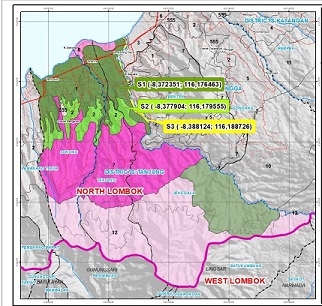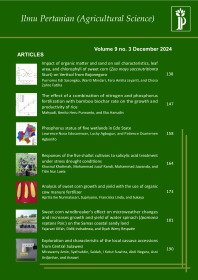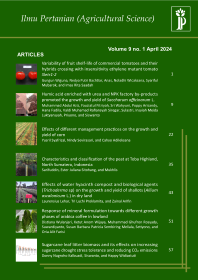
Productivity and profitability of peanut at various land suitability in North Lombok Regency of Nusa Tenggara Barat Province
Ahmadi Suriadi(1*), Fitria Zulhaedar(2), Moh. Nazam(3)
(1) Assessment Institute for Agricultural Technology (AIAT) West Nusa Tenggara (BPTP NTB) Jalan Raya Peninjauan Narmada, Lombok Barat, Nusa Tenggara Barat 83371, Indonesia
(2) Assessment Institute for Agricultural Technology (AIAT) West Nusa Tenggara (BPTP NTB) Jalan Raya Peninjauan Narmada, Lombok Barat, Nusa Tenggara Barat 83371, Indonesia
(3) Assessment Institute for Agricultural Technology (AIAT) West Nusa Tenggara (BPTP NTB) Jalan Raya Peninjauan Narmada, Lombok Barat, Nusa Tenggara Barat 83371, Indonesia
(*) Corresponding Author
Abstract
Peanuts (Arachis hypogaea L.) are the second main commodity in the annual cropping pattern in lowland and dryland in North Lombok District of NTB Province. However, peanut productivity is still low, and it varies across regions, which might be due to the traditional crop management of farmers and the difference in land suitability classes. Effects of crop varieties and land suitability on the peanut productivity have not been evaluated in the Region. Thus, this study aimed to evaluate the productivity and profitability of peanut varieties at various land classification in KLU NTB. The experiment was arranged in a Split Plot Design consisting of three classes of land suitability as main plot and six peanut varieties as sub-plot with three replications. The results showed that the land suitability classes have a significant effect on the agronomic variables of peanut varieties, including plant height, number of branches, number of pods and productivity. The highest peanut yield was obtained at suitable land class (S1), followed by moderately suitable land class (S2) and marginally suitable land class (S3) at 2.37 ton.ha-1, 2.08 ton.ha-1 and 1.71 ton.ha-1, respectively. Likewise, the R/C ratio follows a similar pattern to productivity in various land suitability classes. The highest yield (above 2 ton.ha-1) in each land suitability class was produced by Kelinci variety, followed by Tuban, Bima and Talam varieties. Those varieties have potential prospective to be developed in North Lombok Regency.
Keywords
Full Text:
PDFReferences
Adeboye, A. S., Fayemi, O. E., Bamgbose, A., Adewunmi, A., and Sobowale, S.S. (2018). Towards the development of peanut–wheat flour composite dough: influence of reduced-fat peanut flour on bread quality. J. Food Process Pres, 42(1), pp. e13385.
Akhtar, S., Khalid, N., Ahmed, I., Shahzad, A., and Suleria, H.A.R. (2014). Physicochemical characteristics, functional properties, and nutritional benefits of peanut oil: a review. Crit. Rev. Food. Sci. Nutr., 54(12), pp. 1562–1575.
Arya, S. S., Salve, A. R., and Chauhan, S. (2016) Peanuts as functional food: a review. J. Food Sci. Technol., 53(1), pp. 31–41.
Balai Penelitian Tanaman Aneka Kacang dan Umbi. (2016). Deskripsi varietas unggul kacang tanah (1950-2016). 1st ed. Malang: Balai Penelitian Tanaman Aneka Kacang dan Umbi. Available at: http://balitkabi.litbang.pertanian.go.id/wp-content/uploads/2016/09/kacangtanah.pdf [Accesed 23 September 2020]
Balai Besar Sumberdaya Lahan Pertanian. (2011). Petunjuk teknis evaluasi lahan untuk komoditas pertanian. 1st ed. Bogor: Balai Besar Penelitian dan Pengembangan Sumberdaya Lahan Pertanian. Badan Penelitian dan Pengembangan Pertanian, pp. 166
Badan Pusat Statistik Kabupaten Lombok Utara. (2017). Lombok Utara dalam angka 2017. 1st ed. Tanjung: Badan Pusat Statistik Kabupaten Lombok Utara. Available at: https://lombokutarakab.bps.go.id/publication/2015/10/01/8476fb1d7988235c78a12934/kabupaten-lombok-utara-dalam-angka-tahun-2015.html [Accesed 23 September 2020]
Didagbe, O. Y., Pascal, H., Dedehouanou, H., Sina, H., Bello, D. O., Toukourou, F., and Moussa, L. B. (2015). Characterization of the peanut production systems in their main agroecological regions in Benin. European Scientific Journal, 11(33), pp. 242-261.
Food and Agriculture Organization. (2013). WTO agreement on agriculture: the implementation experience-developing country case studies. [online]. Available at: http://www.fao.org/3/y4632e/y4632e00.htm#Contents [Accesed 23 September 2020]
Faronika, M.. L., Siregar, A. M., and Hasyim, H. (2013). Evaluasi produktifitas dan kualitas beberapa varietas kacang tanah (Arachis hypogaea L.) di tanah bertekstur liat. Jurnal Online Agroekoteknologi, 1(2), pp. 2337-6597.
Hayati. M., Marliah, A., and Fajri, H. (2012). Pengaruh varietas dan dosis pupuk SP-36 terhadap pertumbuhan dan hasil tanaman kacang tanah (Arachis hypogaea L.). Jurnal Agrista, 16(1), pp. 7-13.
Irmansyah, T., Muhammad, R., Ferry, E.T., and Sitepu. (2017). Pertumbuhan dan produksi dua varietas kacang tanah (Arachis hypogaea L.) terhadap waktu aplikasi pupuk kandang sapi. Jurnal Agroekoteknologi, 5(1), pp. 152-159.
Jain, R.S., Jain, N.K., Meena, H.N., and Chakraborty, K. (2018). Productivity, nutrient, and soil enzymes influenced with conservation agriculture practices in peanut. Agronomy Journal, 110(2), pp. 1-8.
Katundu, M.A., Mwanahawa, L., Mhina, A.G., Mbeiyererwa, and Neema, P.K. (2014). Socio-economic factors limiting smallholder groundnut production in Tabora Region. [online]. The 18th Research on Poverty Alleviation (REPOA)’s Annual Research Workshop Available at: https://www.researchgate.net/publication/282133381_Socio-Economic_Factors_Limiting_Smallholder_Groundnut_Production_in_Tabora_Region [Accesed 23 September 2020]
Munsaka, E. (2013). Factors influencing the productivity of groundnuts among smallholder farmers in Zambia's Eastern Province. Thesis. Department of Agricultural Economics and Extension Education of the University of Zambia.
Nazam, M., Zulhaedar, F., and Suriadi, A. (2015). Potensi pengembangan kacang tanah di Kabupaten Lombok Utara. Nusa Tenggara Barat. Prosiding Seminar Nasional Sistem Informasi dan Pemetaan Sumberdaya Lahan Mendukung Swasembada Pangan. Buku II Pemetaan Sumberdaya Lahan. Bogor. pp. 99-112.
Nazam, M., Zulhaedar, F., Suriadi, A., and Sudjudi. (2014). Pewilayahan komoditas pertanian berdasarkan zona agroekologi skala 1:50.000 di Kabupaten Lombok Tengah dan Lombok Utara. Mataram: Balai Pengkajian Teknologi Pertanian NTB., pp. 95
Purnomo, S., Kasno, A., Rahmianna, A.A., Mejaya, I.M.J., and Harnowo, D. (2016). Kacang tanah – inovasi teknologi dan pengembangan produk. 1st ed. Jakarta, Indonesia: Balai Penelitian Tanaman Aneka Kacang dan Umbi, pp. 170-195.
Pusat Data dan Sistem Informasi Pertanian. (2015). Outlok komoditas pertanian sub sektor tanaman pangan. Kacang tanah. 1st ed. Jakarta: Pusat Data dan Sistem Informasi Pertanian Kementerian Pertanian, pp. 75.
Pusat Data dan Sistem Informasi Pertanian. (2018). Buletin konsumsi pangan 9(2). [online] Available at: http://epublikasi.setjen.pertanian.go.id/epublikasi/buletin/konsumsi/2018/Buletin_Konsumsi_Pangan_Semester_2_2018/files/assets/basic-html/page1.html [Accessed 15 January 2021].
Rabo, A. S. and Ahmed, H. G. (2013). Effect of tillage practices on the growth and yield of groundnuts (Arachis hypogea) at Dambatta, Kano, Nigeria. International Journal of Scientific & Technology Research, 2(7), pp. 204-206.
Rahman, N., Suntoro, and Sakya, A.T. (2019). Peanut growth and gynophore formation on boron and phosphor applications. SAINS TANAH – Journal of Soil Science and Agroclimatology, 16(1), pp. 57-66
Rahmianna, A.A., Taufiq, A., and Yusnawan, E. (2012). Kualitas dan hasil kacang tanah pada lingkungan dengan perbedaan ketersediaan air dan aplikasi dolomit. Penelitian Pertanian Tanaman Pangan, 31(1), pp. 46-52.
Ritung, S., Nugroho, K., Mulyani, A., and Suryani, E. (2011). Petunjuk teknis evaluasi lahan untuk komoditas pertanian. 2nd ed. Bogor: Balai Besar Penelitian dan Pengembangan Sumberdaya Lahan Pertanian, pp. 36.
Siringo, D.M., Hussein, S., Mark, L., Patrick, O., and Omari, M. (2018). Groundnut production constraints, farming systems, and farmer-preferred traits in Tanzania. Journal of Crop Improvement, 32(6), pp. 812-828.
Syed, F., Arif, S., Ahmed, I., and Khalid, N. (2020). Groundnut (Peanut) (Arachis hypogaea). In: B. Tanwar, and A. Goyal, eds., Oilseeds: Health Attributes and Food Applications, 1st ed. Singapore: Springer Nature Singapore Pte Ltd., pp. 93-122.
Toomer, O. T. (2018). Nutritional chemistry of the peanut (Arachis hypogaea). Critical Reviews in Food Science and Nutritiona, 8(17), pp. 1-12.
Tridge.com. (2021). Import overview of top 10 countries. [online] Available at: https://www.tridge.com/intelligences/peanut/import [Accessed 19 April 2021].
Trustinah. (2015). Plasma nutfah kacang tanah. Monografi balai penelitian kacang-kacangan dan umbi-umbian. Malang: Balai Penelitian Tanaman Aneka Kacang dan Umbi, pp. 60-83.
Article Metrics
Refbacks
- There are currently no refbacks.
Ilmu Pertanian (Agricultural Science) ISSN 0126-4214 (print), ISSN 2527-7162 (online) is published by Faculty of Agriculture Universitas Gadjah Mada collaboration with Perhimpunan Sarjana Pertanian Indonesia (PISPI) and licensed under a Creative Commons Attribution-ShareAlike 4.0 International License.













